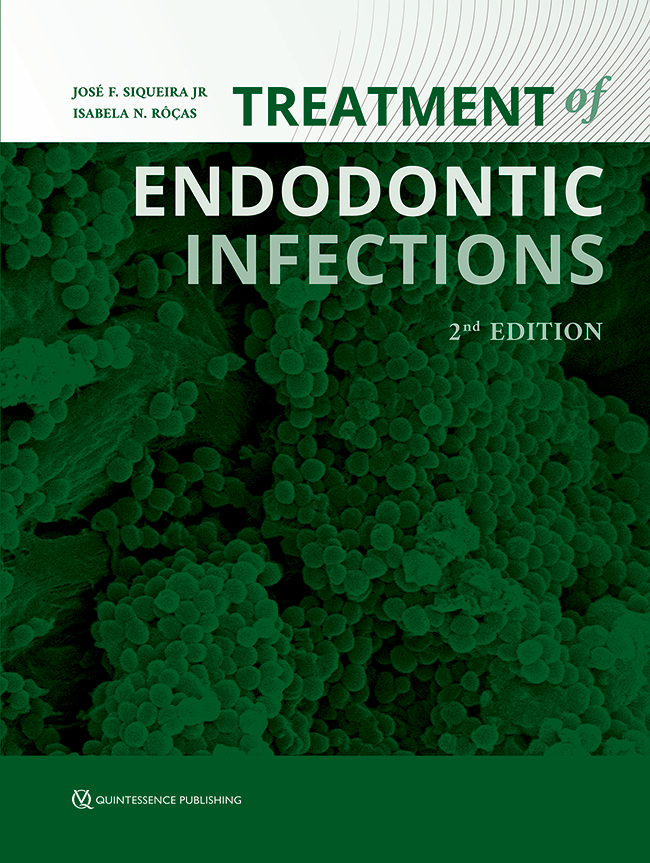ENDO, 1/2013
Pages 41-46, Language: EnglishVieira, Márcia V. B. / Lopes, Weber S. P. / Neves, Monica A. S. / Gama, Tulio G. / Moreno, Jaime O. / Rocas, Isabela N. / Siqueira jr., José F. / Armada, Luciana / Alves, Flavio R. F.Objective: To evaluate the percentage of filled area of oval-shaped root canals.
Materials and methods: Thirty-four mandibular incisors, 42 mandibular premolars and 50 mandibular molars (distal roots only) (n = 126 teeth) were resected 1 and 5 mm from the apex and the cross sections evaluated. All treatments were performed by undergraduate students, who were not aware of the cross-sectional shape of the canal. Obturation was performed using the lateral compaction technique of gutta-percha with sealer.
Results: The findings demonstrated that although all treated root canals were oval-shaped at 5 mm short, the vast majority of them were round at the 1-mm level. The percentage of the total filling area at the 1-mm level was 79% (range: 20-100%) for incisors, 89% (range: 46-100%) for premolars, and 97% (range: 60-100%) for the molar distal root. Correspondent values for the 5-mm level were 92% (range: 52-100%) for incisors, 99% (range: 86-100%) for premolars, and 96% (range: 78-100%) for molars. Gutta-percha was always the major component of the filling mass. At the 1-mm level, the mean proportion of gutta-percha ranged from 66% to 79%, while at the 5-mm level it ranged from 62.5% to 76%.
Conclusion: The findings confirmed that the quality of the root canal filling is compromised in ovalshaped canals, and suggested that this may be more likely a limitation of the technique than a matter of the operator's expertise.
Keywords: endodontic treatment, gutta-percha, lateral compaction technique, oval root canals, pre-clinical training, root canal filling
Endodontie, 1/2010
Pages 29-36, Language: GermanSiqueira jr., José F. / Rôças, Isabela N. / Veiga, Leonardo M. / Lopes, Hélio P. / Oliveira, Julio C. M. / Alves, Flávio R. F.Chronische Schmerzen, die nach einer endodontischen Therapie auftreten oder sie überdauern, stellen einen unerwünschten Zustand dar und müssen für eine adäquate Therapie korrekt diagnostiziert werden. Die Benennung einiger Fälle als "mysteriös" ist meistens auf einen Mangel an Fachwissen oder klinische Erfahrung zurückzuführen, aber auch Unzulänglichkeiten diagnostischer Hilfsmittel können zu Fehldiagnosen und Verwirrungen führen. Die Hauptursachen chronischer postoperativer Beschwerden werden nicht immer korrekt erkannt; sie umfassen: a) persistierende/sekundäre intraradikuläre Infektionen; b) persistierende Entzündungen in Fällen mit nicht erkannter Läsion; c) nicht festgestellte Überfüllung; d) unbehandelte Wurzelkanäle; e) Wurzellängsfrakturen oder -risse, f) falscher Zahn; g) nichtodontogene Schmerzen; h) zentrale Sensibilisierung (Risikofaktoren: präoperative Beschwerden, frühere schmerzhafte Behandlung). Der Zahnarzt sollte diese möglichen Gründe berücksichtigen, um mit Hilfe einer "Checkliste" in schwierigen Fällen die Ursache für die Beschwerden identifizieren und eine korrekte Therapie einleiten zu können.
Keywords: Parodontitis apicalis, digitale Volumentomographie, Wurzelkanalbehandlung, persistierende Infektion, postoperative Schmerzen, sekundäre Infektionen
ENDO, 4/2009
Pages 269-274, Language: EnglishSiqueira jr., José F. / Rôcas, Isabela N. / Veiga, Leonardo M. / Lopes, Hélio P. / Oliveira, Julio C. M. / Alves, Flávio R. F.Chronic pain that arises or persists after endodontic treatment is an undesirable condition that requires proper diagnosis in order to be adequately approached. Some so-called 'mysterious' cases are usually related to limited knowledge or clinical inexperience, but inadequacies of diagnostic tools can also lead to misdiagnosis and confusion. The main causes of chronic post-treatment pain not always promptly recognised are outlined in this paper and include: i) persistent/secondary intraradicular infection; ii) persistent inflammation-undetected lesion; iii) unnoticed overfilling; iv) missed canals; v) vertical root fracture or crack; vi) wrong tooth; vii) non-odontogenic pain; and viii) central sensitisation (risk factors: preoperative pain, previous painful treatment). By having all of these possible causes in mind, clinicians may create a checklist for the possible reason(s) for pain in difficult individual cases and act proactively to offer the best therapeutic solution.
Keywords: apical periodontitis, cone-beam computed tomography, endodontic treatment, persistent infection, post-treatment pain, secondary infection




